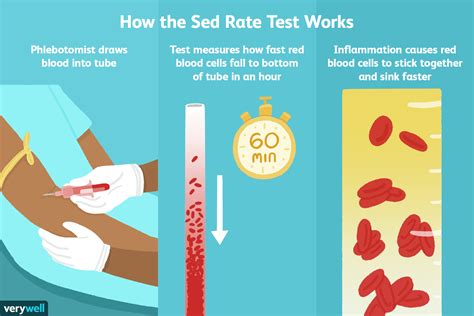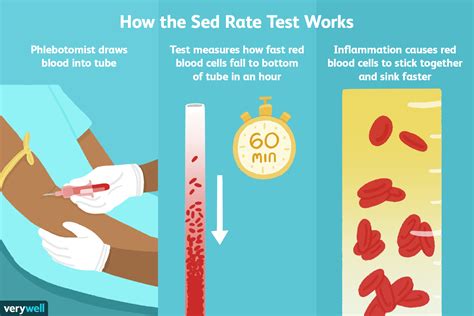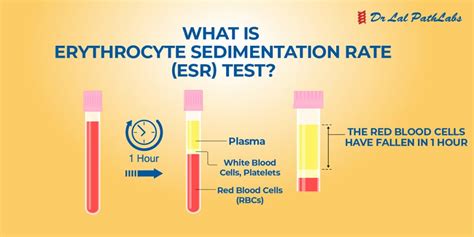Intro
Learn about the Sed Rate Sedimentation Test, a blood test measuring inflammation via erythrocyte sedimentation rate (ESR), helping diagnose conditions like rheumatoid arthritis, lupus, and infections, with results indicating disease activity and monitoring treatment efficacy.
The sed rate sedimentation test, also known as the erythrocyte sedimentation rate (ESR) test, is a widely used medical laboratory test that measures the rate at which red blood cells settle to the bottom of a test tube containing a blood sample. It is a non-specific test that can indicate the presence of inflammation or infection in the body. The sed rate test has been used for many years to help diagnose and monitor various medical conditions, including autoimmune disorders, infections, and cancers.
The sed rate test is a simple and relatively inexpensive test that can provide valuable information about a person's overall health. It is often used in conjunction with other laboratory tests, such as the C-reactive protein (CRP) test, to help diagnose and monitor conditions such as rheumatoid arthritis, lupus, and other inflammatory diseases. The test is also used to monitor the effectiveness of treatment and to detect potential complications or relapses.
The sed rate test is based on the principle that red blood cells will settle to the bottom of a test tube at a faster rate when there is inflammation or infection present in the body. This is because the red blood cells become clumped together, or agglutinated, in response to the presence of inflammatory proteins, such as fibrinogen and other acute-phase reactants. The rate at which the red blood cells settle is measured in millimeters per hour (mm/h), and the result is compared to a reference range to determine if it is within normal limits.
What is the Sed Rate Sedimentation Test?

How is the Sed Rate Sedimentation Test Performed?
The sed rate sedimentation test is performed by a trained laboratory technician or medical professional. The test requires a blood sample, which is typically collected from a vein in the arm using a needle and syringe. The blood sample is then placed in a test tube containing a substance that prevents the blood from clotting. The test tube is labeled with the patient's name, date, and time of collection, and is then sent to the laboratory for analysis.What are the Benefits of the Sed Rate Sedimentation Test?

What are the Limitations of the Sed Rate Sedimentation Test?
While the sed rate sedimentation test is a useful tool for diagnosing and monitoring various medical conditions, it does have some limitations. These include: * It is a non-specific test, which means that it can be elevated in response to a wide range of conditions, including inflammation, infection, and cancer * It can be influenced by various factors, such as age, sex, and pregnancy * It may not be elevated in all cases of inflammation or infection * It may be elevated in response to other conditions, such as anemia or blood clotting disordersWhat are the Normal and Abnormal Results of the Sed Rate Sedimentation Test?

An abnormal result is typically considered to be:
- Greater than 20 mm/h for adults
- Greater than 15 mm/h for children
- Greater than 30 mm/h for pregnant women
What do the Results of the Sed Rate Sedimentation Test Mean?
The results of the sed rate sedimentation test can provide valuable information about a person's overall health. A high result may indicate the presence of inflammation or infection, while a low result may indicate that there is no significant inflammation or infection present. However, it is essential to interpret the results in conjunction with other laboratory tests and medical evaluations to determine the underlying cause of the elevated or decreased sed rate.What are the Clinical Applications of the Sed Rate Sedimentation Test?

What are the Future Directions of the Sed Rate Sedimentation Test?
The sed rate sedimentation test is a widely used and well-established laboratory test. However, there are ongoing efforts to improve the test and develop new methods for measuring inflammation and infection. Some potential future directions for the sed rate sedimentation test include: * Developing more sensitive and specific tests for measuring inflammation and infection * Improving the accuracy and reliability of the test * Developing new applications for the test, such as monitoring the effectiveness of treatment for various medical conditionsHow is the Sed Rate Sedimentation Test Used in conjunction with Other Laboratory Tests?

What are the Implications of the Sed Rate Sedimentation Test for Patient Care?
The sed rate sedimentation test has significant implications for patient care. The test can provide valuable information about a person's overall health and can help diagnose and monitor various medical conditions. The test can also be used to monitor the effectiveness of treatment and detect potential complications or relapses. However, it is essential to interpret the results of the test in conjunction with other laboratory tests and medical evaluations to determine the underlying cause of the elevated or decreased sed rate.What is the sed rate sedimentation test used for?
+The sed rate sedimentation test is used to measure the rate at which red blood cells settle to the bottom of a test tube, which can indicate the presence of inflammation or infection in the body.
What are the benefits of the sed rate sedimentation test?
+The sed rate sedimentation test is a non-invasive and relatively painless test that can provide valuable information about a person's overall health. It is also a simple and relatively inexpensive test.
What are the limitations of the sed rate sedimentation test?
+The sed rate sedimentation test is a non-specific test that can be elevated in response to a wide range of conditions, including inflammation, infection, and cancer. It can also be influenced by various factors, such as age, sex, and pregnancy.
How is the sed rate sedimentation test performed?
+The sed rate sedimentation test is performed by a trained laboratory technician or medical professional. The test requires a blood sample, which is typically collected from a vein in the arm using a needle and syringe.
What do the results of the sed rate sedimentation test mean?
+The results of the sed rate sedimentation test can provide valuable information about a person's overall health. A high result may indicate the presence of inflammation or infection, while a low result may indicate that there is no significant inflammation or infection present.
We hope this article has provided you with a comprehensive understanding of the sed rate sedimentation test. If you have any further questions or would like to learn more about this topic, please do not hesitate to comment or share this article with others. Additionally, if you have any personal experiences or insights related to the sed rate sedimentation test, we would love to hear from you. By working together and sharing our knowledge, we can promote better health and well-being for everyone.
